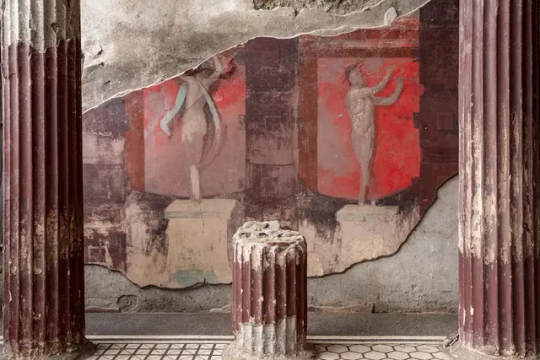Text

Bronze statue fragment uncovered near Geneva, Switzerland.
Roman, 1st century AD
from The Geneva Museum of Art and History
367 notes
·
View notes
Text

Carved agate lion figurine, Elamite, circa 1500 - 1100 BC
from The Louvre
235 notes
·
View notes
Text

Statue of the goddess Sekhmet
New Kingdom, 18th Dynasty, ca. 1391-1353 BC. Reign of Amenhotep III. From Temple of Mut, Karnak. Now in the Egyptian Museum of Turin. Cat. 253
314 notes
·
View notes
Text




Terracotta warriors, Cypro-Archaic II, Cypriot
Buried beneath the unassuming landscape of Agia Eirini lay an ancient sanctuary that had remained hidden for over 2,000 years.
Spanning an area of nearly 4,000 square meters, the site contained an extensive collection of terracotta figures – over 2,000 in total – ranging from life-sized warriors and horsemen to smaller religious and domestic figurines.
The terracotta army at Agia Eirini likely served as a ritual space for the training and veneration of soldiers, with the figures representing both individual warriors and collective military units.
Interestingly, many of the warrior statues were found in a state of partial disrepair, with broken limbs or missing weapons. This suggests that the figures may have been intentionally “killed” or “decommissioned” as part of a ritual process, perhaps to symbolize the transition of a soldier from active duty to the afterlife.
432 notes
·
View notes
Text

mirror handle | c. 1960-1915 BCE | egypt, middle kingdom, 12th dynasty
inscription (as translated by the louvre): Djehutynakht, son of Neheri
in the louvre collection
157 notes
·
View notes
Text

details of a statue of a girl, perhaps artemis | c. 530 BCE | athenian, archaic period
in the acropolis museum collection
569 notes
·
View notes
Text


Attributed to the Tithonos Painter
[Athena holding spear and helmet] Lekythos (oil flask), Greek, Attic ca.480 BCE, terracotta; red-figure, 34.9
The Met Fifth Avenue Inv. 27.122.6
Athena, the warlike protector of Athens, appears alert but serene on this vase. Dressed in a full, richly decorated peplos with a diadem in her hair, she holds her helmet in one hand and her spear, pointed downward, in the other. Her aegis, the protective goatskin ringed with snakes' heads, acts as armor. (MET)
55 notes
·
View notes
Text

Limestone breccia bowl, Egypt, 3200-3000 BC
from The Burrell Collection, Glasgow
224 notes
·
View notes
Photo


Bronze Roman Cavalry Helmet and Mask from Ribchester, England dated between 75 - 125 CE on display at the Great North Museum in Newcastle, England
Masked cavalry helmets were thought to be designed to copy the Middle Eastern cataphract armour popular in the Parthian empire. Parade armour was often decorated with motifs such as animals, gods and mythical figures. These often had special meanings for cavalrymen and tell us about their superstitions and beliefs.
Photographs taken by myself 2017
232 notes
·
View notes
Text



~ Neck Ring.
Date: 500–300 B.C.
Culture: Celtic
Medium: Bronze
772 notes
·
View notes
Text

Kees Scherer - Temple of Nefertari at Abu Simbel, Egypt, 1965-1968
12K notes
·
View notes
Text

The “Bikini Girls” Mosaic,
Villa Romana del Casale, Piazza Armerina, Sicily
4th century with later additions (perhaps after the AD 365 earthquake)
The Villa is arguably one of the best-preserved and best-known Roman villas and contains one of the most important collections of late Roman mosaic pavements in the Mediterranean.
Villa del Casale also boasts an amazing collection of mural paintings that covered the walls of the residence.
(Image: In the upper left corner, the geometric mosaic of the preceding phase is visible).
99 notes
·
View notes
Text






The "Dionysian fresco,"
Dubbed the "house of Thiasos" by archaeologists, was unearthed from a banquet hall amid excavations to Insula 10 Regio IX in Pompeii.
All images courtesy Parco Archeologico di Pompei
1K notes
·
View notes
Text

Persephone
(Votive plaque) Representing Hades and Persephone enthroned. Hades holds a phiale, from Epizephyrian Locri, first half of the 5th century BCE, terracotta Pinax
Museo Archeologico Nazionale di Reggio, Calabria Inv. Z 8/31 (x)
283 notes
·
View notes
Text




Attributed to the manner of the Meidias Painter
[Aphrodite] Pyxis (box), Greek, Attic ca.420/410 BCE, terracotta; red-figure, 8.3 cm
The Met Fifth Avenue Inv. 09.221.40a, b
The representation here shows the typical Athenian lady surrounded by attendants holding caskets and vases for oil. Its significance is altered by the inscriptions, which identify Aphrodite as the seated figure and her companions as Peitho (Persuasion), Hygeia (Health), Eudaimonia (Good Fortune), Eukleia (Good Repute), Eunomia (Good Order), Paidia (Play). The pyxis was undoubtedly a wedding gift. (MET)
75 notes
·
View notes

